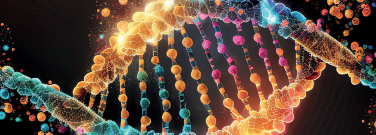Gene Sequencing: A Brief History

By Iva Fedorka
Gene sequencing isn’t new, and it’s undergone many changes during the past 50 years. After the structure of DNA was determined in the 1950s, many attempts were made to determine its sequence, or the order of its nitrogenous bases.
Robert Holley, an American biochemist, sequenced the first tRNA in 1965, for which he was awarded the Nobel Prize in 1986. By 1972, DNA was sequenced using enzymes to break RNA into smaller sections, isolate these oligonucleotides, and separate them using electrophoresis and chromatography.
The First Generation
In the 1970s, Fredrick Sanger and his collaborators at the Medical Research Council Laboratory of Molecular Biology in Cambridge, United Kingdom, were working on an alternative DNA sequencing method. The “chain termination method,” developed in 1977, uses radiolabeled and partially digested oligonucleotides to analyze pieces of the molecule. Later known as the Sanger method, it was widely used throughout the 2000s and earned Sanger a Nobel Prize in 1980.
Although other sequencing methods were also developed around the same time, they were all technically complex, time consuming, and tedious. The four DNA bases (A, C, G, and T) had to be identified by examining an autoradiogram and recording the data manually. The electrophoresis alone took about 12 hours to complete, and an equal amount of time was spent on radiography processing. Many more hours were required to read and record the sequences.
The Second Generation
The key to the next phase was automating and miniaturizing the assays to be able to perform multiple reactions at once. In 1987, scientists at Applied Biosystems* automated the Sanger sequencing process. DNA fragments were labeled with fluorescent dyes and data was collected and analyzed on a computer.
Additional sequencing techniques were developed from 1996 through 2005. Some of these used the luminescence generated by pyrophosphate synthesis during sequencing, measured the hydrogen ions released during synthesis, or incorporated fluorescent dyes to detect successful synthesis.
The Third Generation
Single molecule real-time (SMRT) sequencing technologies (Pacific Biosciences, 2010) are considered by many to be the third generation of DNA sequencing. This type of sequencing uses zero-mode waveguides (ZMW), or “nanoholes,” that contain a single DNA polymerase enzyme to incorporate a single nucleotide. Each nucleotide is labelled with a different fluorescent dye; signals emitted in the process are detected and recorded.
What’s Next?
Many novel and personalized medical treatments are now based on genetic sequencing. As the technology continues to evolve, costs will likely decrease further, making earlier disease detection and treatment more accessible to all.
The Human Genome Project (HGP) completely mapped the first human reference genome in 2003. Using the Sanger method, it took 13 years and several billion dollars to complete. Using 2022 sequencing techniques, the project would have taken less than two weeks and cost around $600.
*Now part of, and a trademark of, Thermo Fisher Scientific.
Discussion Questions
- What are Nobel Prizes and to whom are they awarded?
- What are the DNA bases and what function do they serve in the structure of DNA?